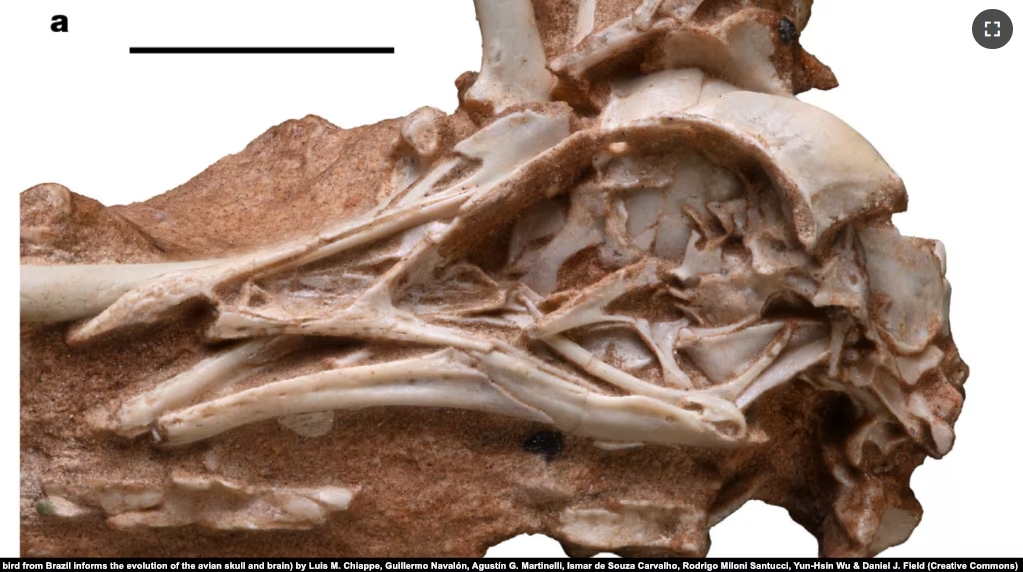The brains of today’s birds show a level of intelligence and behavioral complexity rivaled only by mammals. But scientists do not fully understand how bird brains have changed over millions of years from the form they had as dinosaurs. That understanding is now growing thanks to a fossil discovery in Brazil.
Researchers unearthed the remains, or fossil, of a head bone, or skull, of a bird species not known before. It has been named Navaornis hestiae. The fossil was in such good condition that scientists were able to create a computer image of its brain and inner ear structures. It lived in a dry area about 80 million years ago during the Cretaceous Period, near the end of the age of dinosaurs.
One of a kind
“This finding is one-of-a-kind,” said University of Cambridge fossil expert Guillermo Navalón, a lead researcher of the study. It appeared this month in the publication Nature.
Birds developed from small, feathered dinosaurs during the Jurassic Period. The Navaornis discovery filled in a 70-million-year gap in the understanding of the development of the bird, dating back to the earliest-known bird Archaeopteryx. It lived about 150 million years ago in what is now Europe.
The researchers said the Navaornis skull has a bill and eye shape like modern birds. Its brain shows both modern and ancient elements, and some that are in between.

Well-preserved example
Luis Chiappe is a fossil scientist at the Natural History Museum of Los Angeles County in California and a co-writer of the study.
He said scientists rarely find such skulls of early birds, “and this one is the best preserved ever.”
Daniel Field is a fossil scientist at the University of Cambridge and the study’s lead writer. He said scientists have long struggled to understand how and when the brains and intelligence of birds developed. “The field has been awaiting the discovery of a fossil exactly like this one,” he said.
The Navaornis brain – measuring about 10 millimeters across – is smaller, relative to skull size, than that of modern birds. But the skull is larger and more complex than that of Archaeopteryx.
Its cerebellum, a brain structure that in living birds helps with motor control during flight, was smaller than in today’s bird species and more like Archaeopteryx’s. But its brain was connected to the spinal cord in a way similar to modern birds, as well as humans. It was unlike Archaeopteryx and the dinosaurs from which birds evolved.
Navaornis also had something special – its inner ear organ for balance is larger than in any other known bird.
The fossil included 80 percent of the bird’s bone structure, or skeleton. The scientists say they believe the bird could fly well based on their examination of the remains.
Its name means “Nava’s bird,” named for William Nava, the scientist who discovered the fossil in 2016 in the southeastern Brazilian state of Sao Paulo.
No direct line to today’s birds
Navaornis lived during the Cretaceous period, but none of these birds survived the asteroid strike that took place 66 million years ago. That means there is no direct line from Navaornis to today’s birds, and its modern-looking abilities and appearance developed separately from theirs.
The researchers said the bird ate insects and seeds it could take in whole. It lived side-by-side with huge, long-necked plant-eating dinosaurs and large meat-eating dinosaurs.
Field said if you gave it a quick look you might think it was like a living bird. But a closer look would show you some important differences – like claws coming out of its wings.
I’m Jill Robbins.
Will Dunham reported this story for Reuters. The images are licensed under Creative Commons Attribution 4.0 International License (https://www.nature.com/articles/s41586-024-08114-4#rightslink). Jill Robbins adapted the report for Learning English.
______________________________________________
Words in This Story
rival – v. to be as good or almost as good as (someone or something)
mammal – n. a type of animal that feeds milk to its young and that usually has hair or fur covering most of its skin
fossil – n. something (such as a leaf, skeleton, or footprint) that is from a plant or animal which lived in ancient times and that you can see in some rocks
species – n. biology. a group of animals or plants that are similar and can produce young animals or plants
gap – n. a difference between two people, groups, or things — often + between
skull – n. the structure of bones that form the head and face of a person or animal
evolve – v. to change or develop slowly often into a better, more complex, or more advanced state; to develop by a process of evolution
paleontologist – n. the science that deals with the fossils of animals and plants that lived very long ago especially in the time of dinosaurs
preserved – adj. kept in good condition over a long period of time
asteroid – n. any of the small rocky celestial bodies found especially between the orbits of Mars and Jupiter
claw – n. a sharp usually slender and curved nail on the toe of an animal
